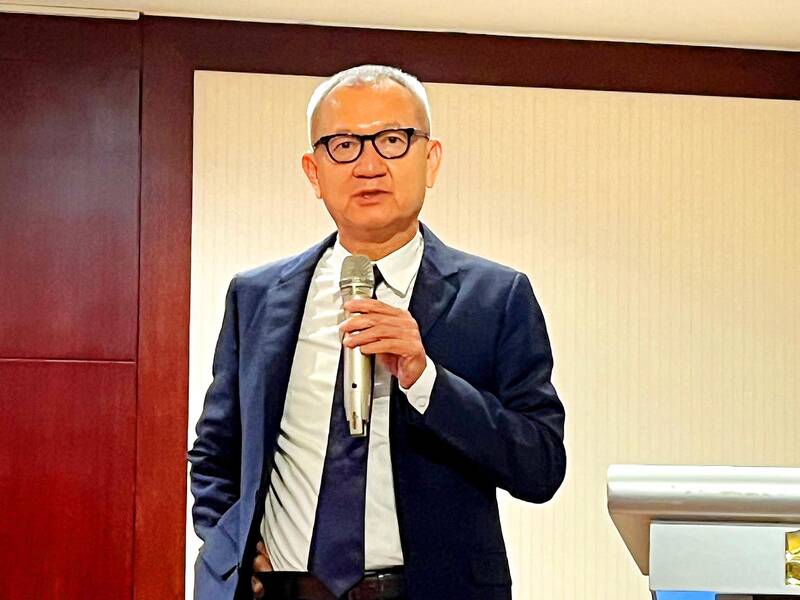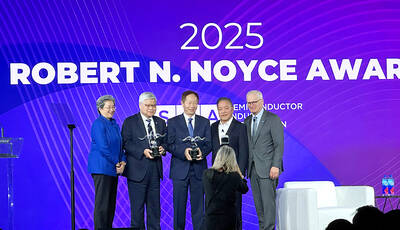Passive components maker Yageo Corp (國巨) yesterday said it expects the acquisition of two European sensor companies to add about NT$13 billion (US$403 million) to its revenue next year, helping the company broaden its product offerings to high-end sensors used in automotive and industrial devices.
The sensor market is a new area for Yageo, the company said.
The new acquisitions would also help the company better shield against industrial downturns and economic headwinds, as its premium products are less volatile than standard passive components used in consumer electronics.

Photo: Chang Hui-wen, Taipei Times
“The acquisitions will accelerate Yageo’s expansions into premium markets such as the automotive segment, allowing the company’s operation to better weather downturns,” Yageo chairman Pierre Chen (陳泰銘) told an investors’ conference in Taipei.
High-end products are to account for 80 percent of the company’s total revenue following the transactions, compared with 75 percent currently, Chen said.
Additionally, Yageo this year could hit its target of boosting automotive-related product revenue to 22 percent, one year earlier than expected, he said.
Chen made the remarks after the company last month unveiled plans to acquire German sensor supplier Heraeus Holding GmbH and France-based Schneider Electric’s Telemecanique sensor business for NT$2.84 billion and NT$12.4 billion respectively.
The firm has a good chance to complete the transactions in the first half of next year, he said.
With higher revenue from premium products, Yageo does not expect to experience the significant drop in gross margin seen by its peers, Chen said, adding that local competitors generated more than 90 percent from standard passive components, and saw gross margin dip to just above 10 percent from 30 percent.
“Companies with high exposure to standard products are going to experience a tough time during the next two years,” he said.
The passive component industry is entering into an inventory-driven downward trend, although excessive inventories in supply chains are expected to level off in the second or third quarter of next year, Chen said.
Yageo has been trying to enter the sensor market since 2015, he added.
The company now has grown into the world’s No. 3 maker of passive components through 20 mergers and acquisitions over the past two decades. Revenue expanded to NT$106.54 billion last year, surging 58 percent from 2020.
Yageo operates 42 factories in 28 countries. About 80 percent of its 45,000 employees are based abroad.

Shiina Ito has had fewer Chinese customers at her Tokyo jewelry shop since Beijing issued a travel warning in the wake of a diplomatic spat, but she said she was not concerned. A souring of Tokyo-Beijing relations this month, following remarks by Japanese Prime Minister Sanae Takaichi about Taiwan, has fueled concerns about the impact on the ritzy boutiques, noodle joints and hotels where holidaymakers spend their cash. However, businesses in Tokyo largely shrugged off any anxiety. “Since there are fewer Chinese customers, it’s become a bit easier for Japanese shoppers to visit, so our sales haven’t really dropped,” Ito

The number of Taiwanese working in the US rose to a record high of 137,000 last year, driven largely by Taiwan Semiconductor Manufacturing Co’s (TSMC, 台積電) rapid overseas expansion, according to government data released yesterday. A total of 666,000 Taiwanese nationals were employed abroad last year, an increase of 45,000 from 2023 and the highest level since the COVID-19 pandemic, data from the Directorate-General of Budget, Accounting and Statistics (DGBAS) showed. Overseas employment had steadily increased between 2009 and 2019, peaking at 739,000, before plunging to 319,000 in 2021 amid US-China trade tensions, global supply chain shifts, reshoring by Taiwanese companies and

Taiwan Semiconductor Manufacturing Co (TSMC, 台積電) received about NT$147 billion (US$4.71 billion) in subsidies from the US, Japanese, German and Chinese governments over the past two years for its global expansion. Financial data compiled by the world’s largest contract chipmaker showed the company secured NT$4.77 billion in subsidies from the governments in the third quarter, bringing the total for the first three quarters of the year to about NT$71.9 billion. Along with the NT$75.16 billion in financial aid TSMC received last year, the chipmaker obtained NT$147 billion in subsidies in almost two years, the data showed. The subsidies received by its subsidiaries —

Taiwan Semiconductor Manufacturing Co (TSMC) Chairman C.C. Wei (魏哲家) and the company’s former chairman, Mark Liu (劉德音), both received the Robert N. Noyce Award -- the semiconductor industry’s highest honor -- in San Jose, California, on Thursday (local time). Speaking at the award event, Liu, who retired last year, expressed gratitude to his wife, his dissertation advisor at the University of California, Berkeley, his supervisors at AT&T Bell Laboratories -- where he worked on optical fiber communication systems before joining TSMC, TSMC partners, and industry colleagues. Liu said that working alongside TSMC